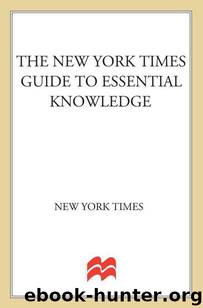The New York Times Guide to Essential Knowledge: A Desk Reference for the Curious Mind by The New York Times

Author:The New York Times [Times, The New York]
Language: eng
Format: epub
Publisher: Macmillan
Published: 2011-10-25T04:00:00+00:00
Eurasia
Indo-European embraces about 150 languages spoken by some 3 billion people worldwide; it is the most widely distributed language family, evidence of a persistent Indo-European drive for territorial expansion throughout history. It comprises several subfamilies, including Indo-Iranian (Sanskrit, Hindi, Bengali, Sinhalese, Pashto, Farsi, and others); Italic or Romance (Latin, Italian, French, Spanish, Portuguese, Catalan, Romanian, and others); Germanic (Gothic, German, Dutch, English, Swedish, Icelandic, and others); Celtic (Gaelic, Welsh, Breton, and others); Baltic (Latvian, Lituanian, and others); Slavic (Slavonic, Russian, Polish, Czech, Serbo-Croation, and others); and Albanian, Greek, and Armenian.
Other language families of Eurasia include Caucasian (Georgian, Circassian, Chechen, the several languages of the Kartavelian subfamily, and many others) and Uralic (Finnish, Estonian, Hungarian, and Saami). Turkic (Turkish, Uzbek, Uighur, and others), Mongolic (such as Mongolian, Buryat, and Kalmyk), and Tungusic (Manchu and others) are grouped together by some linguists as the Altaic language family, and the Uralic and Altaic families are sometimes combined as the Uralic-Altaic language family; but those amalgamations are not accepted by all authorities. Korean and Japanese are sometimes also described as Altaic languages; this identification is highly controversial. Despite obvious similarities and many years of research, no organic link between Korean and Japanese has been proven; some authorities conclude that Korean is linguistically isolated, and Japanese is part of the small Koguryoic language family (along with Okinawan and several extinct languages of Korea and northeastern China). The smallest of the world’s language families is Chukchi-Kamchatkan (also known as Paleo-Siberian), comprising five languages spoken by fewer than 25,000 people in northeastern Siberia.
Download
This site does not store any files on its server. We only index and link to content provided by other sites. Please contact the content providers to delete copyright contents if any and email us, we'll remove relevant links or contents immediately.
| Coloring Books for Grown-Ups | Humor |
| Movies | Performing Arts |
| Pop Culture | Puzzles & Games |
| Radio | Sheet Music & Scores |
| Television | Trivia & Fun Facts |
The Infinite Retina by Robert Scoble Irena Cronin(6156)
Harry Potter and the Cursed Child: The Journey by Harry Potter Theatrical Productions(4439)
The Sports Rules Book by Human Kinetics(4290)
Molly's Game: From Hollywood's Elite to Wall Street's Billionaire Boys Club, My High-Stakes Adventure in the World of Underground Poker by Molly Bloom(3485)
A Knight of the Seven Kingdoms by George R R Martin(3190)
Quidditch Through the Ages by J.K. Rowling(3062)
How To by Randall Munroe(3032)
Flowers For Algernon by Daniel Keyes(3019)
Quidditch Through the Ages by J K Rowling & Kennilworthy Whisp(2927)
Quidditch Through the Ages by Kennilworthy Whisp by J.K. Rowling(2812)
Stacked Decks by The Rotenberg Collection(2810)
Quidditch through the Ages by J. K. Rowling(2768)
Quidditch Through The Ages by J. K. Rowling(2729)
776 Stupidest Things Ever Said by Ross Petras(2693)
Ready Player One: A Novel by Ernest Cline(2647)
What If?: Serious Scientific Answers to Absurd Hypothetical Questions by Randall Munroe(2637)
Beautiful Oblivion by Jamie McGuire(2569)
The Book of Questions: Revised and Updated by Gregory Stock Ph.d(2516)
Champions of Illusion by Susana Martinez-Conde & Stephen Macknik(2414)
